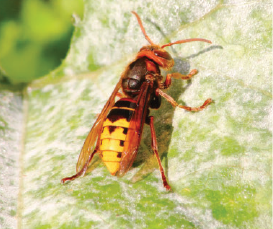| Insects |
Bayer Crawling Insect Killer (Cyphenothrin mix) |
- pressurised container
- extremely flammable
- carbon monoxide may be released
- wear self-contained breathing apparatus
|
| Insects |
Coopex Maxi Smoke Generator |
- contains potassium chlorate (an oxidising agent)
- produces copious fumes rapidly
- wear self-contained breathing apparatus
|
| Cockroach |
Due Pont Advion Cockroach Gel Bait |
- wear self-contained breathing apparatus
|
| Insects |
Fendona 6SC |
- carbon monoxide, carbon dioxide, hydrogen chloride, nitrogen oxides, organochloric compounds can be released
- wear self-contained breathing apparatus and chemical protective clothing
|
| Wasps |
Ficam D |
- dangerous gases are evolved in the event of a fire
- wear self-contained breathing apparatus and protective suit
|
| Fleas |
Beaphar Fleatec Spray |
- extremely flammable aerosol
- pressurised container – may burst if heated
- very toxic to aquatic life with long-lasting effects
|
| Ants |
Maxforce Any Gel Bait |
- dangerous gases are evolved in the event of a fire
- wear self-contained breathing apparatus and protective suit
|
| Insects |
Pybuthrin 33 |
- dangerous gases are evolved in the event of a fire
- wear self-contained breathing apparatus
|
| Wasps |
Wasp Nest Destroyer |
- containers can burst or explode
- carbon monoxide and carbon dioxide can be released
|
| Rodents |
Contrac Blox |
- wear self-contained breathing apparatus and protective clothing
|
| Rodents |
Bell None Toxic Detex Blox |
- wear self-contained breathing apparatus and protective clothing
|
| Rodents |
Racumin Foam |
- dangerous gases are evolved in the event of a fire
- wear self-contained breathing apparatus and protective suit
|
| Rodents |
Ratak Cut Wheat |
- wear self-contained breathing apparatus
|
| Rodents |
Ratimor Brodifacoum |
- carbon monoxide, carbon dioxide and nitrogen oxides can be released
- in case of fire wear self-contained breathing apparatus
|
| Rodents |
Ratimor Brodifacoum S/B Sachets |
- carbon monoxide, carbon dioxide and nitrogen oxides can be released
- in case of fire wear self-contained breathing apparatus
|
| Rodents |
Rodent Indicator Blocks |
|
| Rodents |
Sakarat Bromabait |
- wear self-contained breathing apparatus
|
| Rodents |
Sakarat D Liquid Bait |
- dangerous gases are evolved in the event of a fire
- wear self-contained breathing apparatus and protective suit
|
| Rodents |
Sakarat D Wholewheat |
- wear self-contained breathing apparatus
|
| Rodents |
Solo Blox |
- dangerous gases are evolved in the event of a fire
- wear self-contained breathing apparatus and protective suit
|
| Rodents |
Sorexa D |
- wear self-contained breathing apparatus and chemical protective clothing
|
| Rodents |
Storm Secure Blox |
- carbon monoxide, carbon dioxide, nitrogen oxides can be released
- wear self-contained breathing apparatus and chemical protective clothing
|
| Rodents |
Talon Soft Tubes |
- fire will produce dense black smoke containing hazardous products on combustion
- wear protective clothing and self-contained breathing apparatus
|
| Rodents |
Talon Wax Blocks |
|
| Rodents |
Bell None Toxic Detex Blox |
- wear self-contained breathing apparatus and protective clothing
|
| Rodents |
Supercontrac Blox913041 |
- wear self-contained breathing apparatus and chemical protective clothing
|
| Insects |
Bayer Flying Insect |
- pressurised container
- extremely flammable
- carbon monoxide may be released
- wear self-contained breathing apparatus
|
| Insects |
Hoy Hoy Roach Trap |
- wear self-contained respiratory equipment and full protective suit
- use CO2, dry chemical powder, foam
- prevent runoff into water
|
| Insects |
Effect Ultimum Professional |
- wear self-contained respiratory equipment and full protective suit
- use CO2, dry chemical powder, foam
- prevent runoff into water
|
| Insects |
AquaPy Micro insecticide |
- wear self-contained respiratory equipment and full protective suit
- use CO2, dry chemical powder, foam
- prevent runoff into water
|
| Insects |
Vazor Fumigator |
- wear self-contained respiratory equipment and full protective suit
- use CO2, dry chemical powder, foam
- prevent runoff into water
|
| Rodents |
Sakarat Warfarin Whole Wheat |
- wear self-contained breathing apparatus
|
| Rodents |
Sakarat Brodikill Whole Wheat |
- wear self-contained breathing apparatus
|



